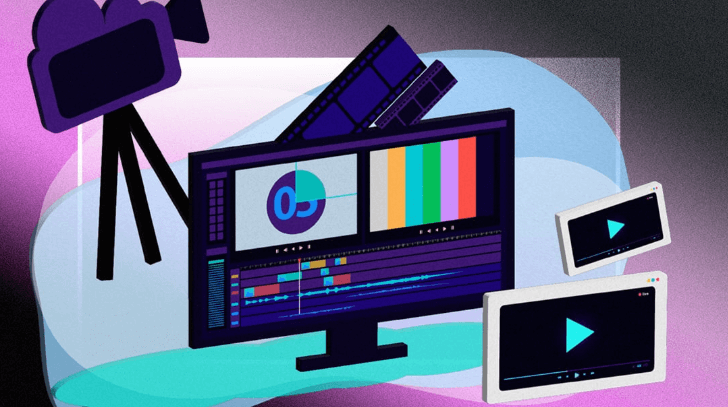Mastering the Art of Video Editing: A Comprehensive Guide

In the ever-evolving landscape of multimedia content creation, video editing stands tall as a crucial element, wielding the power to transform raw footage into captivating narratives that resonate with audiences worldwide. Whether it’s a cinematic masterpiece, a viral YouTube video, or a corporate presentation, the art of video editing serves as the linchpin that bridges the gap between imagination and realization. In this comprehensive guide, we delve deep into the multifaceted world of video editing, exploring its significance, fundamental techniques, advanced strategies, and the array of tools that empower creators to craft compelling visual stories that leave a lasting impact.
The Significance of Video Editing
Video editing is more than just piecing together clips; it’s the alchemy that turns disjointed fragments into a cohesive and immersive experience. At its essence, video editing serves several pivotal purposes:
Storytelling: Video editing is the language through which narratives are woven, emotions are evoked, and messages are communicated. By juxtaposing shots, controlling pacing, and manipulating visuals and sound, editors shape raw footage into compelling stories that engage and captivate audiences.
Aesthetic Enhancement: Beyond storytelling, video editing encompasses the art of enhancing the visual and auditory elements of a production. Through color correction, sound design, and visual effects, editors elevate the overall quality and aesthetic appeal of the video, ensuring it leaves a lasting impression on viewers.
Brand Identity: For businesses and content creators, video editing serves as a tool to establish and reinforce brand identity. Consistent editing styles, graphical elements, and storytelling approaches help distinguish a brand and foster a sense of familiarity and trust among audiences.
Engagement and Retention: In an era inundated with content, the ability to grab and hold viewers’ attention is paramount. Effective video editing techniques such as dynamic cuts, compelling transitions, and captivating visuals play a crucial role in keeping audiences engaged and invested in the content.
Fundamental Techniques in Video Editing
Cutting and Trimming: At the heart of video editing lies the skill of cutting and trimming footage to remove unwanted elements and shape the narrative flow. By meticulously selecting the best moments and eliminating distractions, editors ensure that every frame contributes to the overall storytelling.
Transitions: Transitions serve as the glue that binds individual shots together, facilitating smooth and seamless continuity. Whether it’s a simple cut, a crossfade, or a more elaborate transition effect, the choice of transition can significantly impact the pacing and rhythm of the video.
Color Correction and Grading: The color palette of a video sets the mood, tone, and atmosphere, making color correction and grading essential aspects of the editing process. From adjusting exposure and contrast to fine-tuning color balance and saturation, editors wield powerful tools to enhance the visual appeal and coherence of the footage.
Audio Editing: Sound is as integral to the viewing experience as visuals, if not more. Audio editing involves balancing levels, cleaning up noise, adding music and sound effects, and synchronizing audio with video to create a rich and immersive auditory landscape that complements the visuals.
Visual Effects: From subtle enhancements to elaborate visual spectacles, visual effects can elevate the storytelling and aesthetic appeal of a video. Whether it’s adding motion graphics, text overlays, or CGI elements, editors have a plethora of tools and techniques at their disposal to unleash their creative vision.
Pacing and Rhythm: The pace at which a video unfolds can profoundly influence its impact on the audience. Editors manipulate pacing through the timing and duration of shots, the arrangement of scenes, and the use of editing techniques to create a sense of rhythm that draws viewers deeper into the narrative.
Storyboarding and Previsualization: While editing often begins with raw footage, careful planning and visualization are essential steps in the process. Storyboarding and previsualization techniques allow editors to map out the sequence of shots, plan transitions, and experiment with different editing styles before diving into the actual editing phase.
Advanced Strategies and Creative Approaches
Beyond the fundamental techniques, video editing offers a vast canvas for experimentation and innovation. Here are some advanced strategies and creative approaches that editors can explore to elevate their craft:
Montage and Parallel Editing: Montage sequences and parallel editing techniques can add depth and complexity to storytelling by juxtaposing multiple narrative threads or events simultaneously.
Temporal Manipulation: Playing with the temporal structure of a video, such as employing flashbacks, time-lapses, or slow-motion effects, can imbue the narrative with a sense of dynamism and emotional resonance.
Experimental Editing Styles: Breaking away from traditional editing conventions, experimenting with unconventional transitions, non-linear narratives, and abstract visual techniques can yield bold and striking results that challenge viewers’ perceptions and expectations.
Collaborative Editing and Workflow Optimization: In collaborative environments, efficient workflow management and streamlined communication are essential for maximizing productivity and creativity. Utilizing collaborative editing platforms, cloud-based storage solutions, and project management tools can facilitate seamless collaboration among team members.\
Read also Reasons Why Dental Implants Are Worth It
Tools of the Trade
In the digital age, a plethora of video editing software tools cater to the diverse needs and skill levels of creators. Here are some of the leading video editing software options:
Adobe Premiere Pro: A versatile and feature-rich video editing software favored by professionals for its extensive toolset, seamless integration with other Adobe Creative Cloud applications, and robust support for various video formats and workflows.
Final Cut Pro X: Apple’s flagship video editing software, renowned for its intuitive interface, powerful performance, and seamless integration with macOS and other Apple devices.
DaVinci Resolve: A comprehensive editing, color grading, and post-production software offering professional-grade features and workflows, available in both free and paid versions, making it accessible to a wide range of users.
Avid Media Composer: A stalwart in the professional editing industry, Avid Media Composer is trusted by Hollywood editors for its robust feature set, advanced collaboration tools, and rock-solid stability.
HitFilm Express: A free, feature-rich video editing and visual effects software ideal for beginners and enthusiasts, offering a wide range of tools for creating stunning visual content without breaking the bank.
Conclusion
Video editing is a dynamic and multifaceted craft that blends technical expertise with artistic vision, enabling creators to transform raw footage into immersive visual experiences that resonate with audiences on a profound level. Whether you’re a seasoned professional or a novice enthusiast, mastering the art of video editing opens up a world of possibilities for creative expression and storytelling. By understanding the fundamental techniques, experimenting with advanced strategies, and leveraging cutting-edge tools and technologies, you can unleash your creativity and bring your visual stories to life with unparalleled impact and resonance. Embrace the journey of exploration and discovery, and let your imagination soar as you navigate the ever-evolving landscape of video editing.






